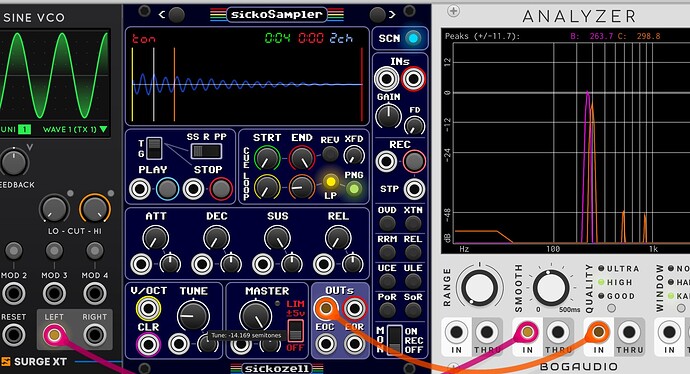Back on the topic: The only synth I have with smart pitch detection features built in is Dawesome Myth. And even for a tuning-nerd musician like me who doesn’t mind tuning stuff by ear, indeed that does save a lot of time in many cases. So your question makes total sense to me.
I’m afraid I don’t know of a way to set that up in VCV though. Doesn’t mean it isn’t possible, but for the record, here’s what I would do to speed up the by-ear method as much as possible:
In words: Take a VCO (Surge Sine is nice), and your sampler with the sample loaded. Don’t patch any v/oct to either. Patch them both into an analyzer (bogaudio is nice cause you can zoom in). The VCO will play middle C, the sample probably won’t. Adjust the pitch of the sample until you see the lowest peaks line up. That should make the sample play in tune, also when you patch in a V/Oct setting (which I think is what you want).
The visualizer alone may or may not be enough to bring it quite perfectly in tune. I’d usually start like this cause it’s fast, and then listen to the outputs at equal volume and fine-tune by ear. Increasing the feedback a bit on the Sine VCO adds some overtones which makes it easier to hear.
And sorry if this is stating the obvious, but given some earlier comments I thought perhaps this can be helpful: There will be a steady wobbling sound (“beating”) when the two pitches are very close to the same pitch, which gets slower and slower as they get closer together, dissappearing completely when they’re dead on. That’s what most musicians are listening for when tuning by ear. Most folks don’t have perfect pitch and indeed many don’t find it easy to tune by ear, but we all have much more sensitive pitch perception for simultaneously sounding notes than for single notes. So making use of that sensitivity makes sense.
Depending on how stable the pitch of your sample is, it may or may not even be possible to get it perfectly lined up. Acoustic instrument samples are rarely consistent enough to get completely beatless from start to finish. In those cases, try to settle for the best average kinda. Or if the pitch drops down conistently (common on guitar and other plucked strings), try to prioritize the beginning of the sample in tune, letting it drop below after that.
Hope that helps!
